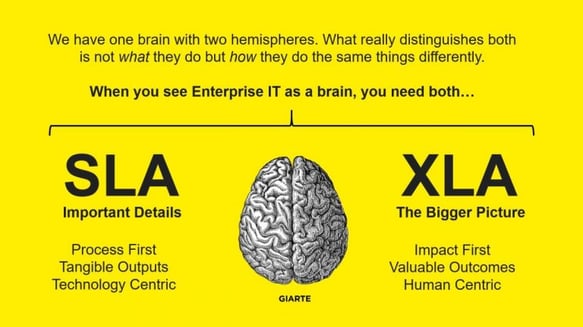
You come across it more and more often. Companies switching from an SLA (Service Level Agreement) to an XLA (eXpercience Level Agreement). You will probably ask yourself: do I have to undergo this change as well? And what exactly are the differences between the two? We'll explain you everything in this article!
First, what is an SLA?
Working with an SLA is a good step if you want your organization to distinguish itself with service. After all, SLA stands for Service Level Agreement and is a contract between the supplier and customer with terms and conditions laid down herein. SLAs are mainly used by IT companies of for other technical services.
An SLA describes the quality of one or more services and, as a result, a customer is aware of the details and costs of the services he or she purchases. Questions such as "What is the up-time of systems?", "What is the supplier's response time when systems fail?" and "What is the cost of each service?" are questions that are answered with an SLA. The supplier can be held to account if he does not deliver the agreed quality.
The focus of an SLA is on technical performance. And because it is mainly about technical factors, IT plays an important role. Only the IT department looks at the end product and mainly gets involved when the use (the customer) has a technical problem that needs to be solved.
Is recording only the technical factors enough?
Customers will be satisfied when the service is delivered as promised, and when a problem does occur, it will be solved with proper working methods in the agreed time frame.However, this is not enough anymore. Today's market and consumer is not only about speed and excellent service, but also about the total experience of a company or brand.
Companies that really offer a memorable experience stick better in the customer’s memory. In our article about the difference between time well spent and time well saved, we explain how to create a memorable experience. Namely, when someone feels that they have spent their time well by being in contact with your organization instead of just saving time.
Experience first, process second – Giarte Media Group
So, what is an XLA?
Research agency Giarte discovered that SLA is now outdated. Nowadays, everything revolves around the customers experience. SLA, where the focus is mainly on the technical field, does not fit in any longer. But where the Service Level Agreement stops, an eXperience Level Agreement, or XLA, continues.
An XLA is more than just a document with conditions. It is more of a guide than a legal document. In an XLA you define your goals from the perspective of an end user and focus on customer satisfaction. By working with an XLA you as an organization get more steering power towards customer experiences.
It's not about what you do, but how you do something
Working with an XLA requires a new way of thinking and acting. Nowadays, it is about looking further and thinking along with your client. This means that you cannot limit yourself to your tasks and say "sorry that's beyond my capabilities". On the contrary, you have to look together with the client at how you can achieve something.
In case of a malfunction (where you agree on a certain response time in an SLA), it is no longer just about whether this has been resolved within the agreed time, but also about how an employee speaks to the person who has indicated the malfunction. Does the customer feel understood and how does he experience this specific interaction with the supplier?
You must give your employees the space to be customer-oriented and to be able to "take that extra step" for a customer. In this way, working with an XLA is also beneficial for employees. When they can offer the best customer experience, this also gives them satisfaction. As an employee, you now have a greater and direct impact on customer satisfaction, get more pleasure from your work and will also be more motivated.
"Let customer satisfaction always take precedence over agreements and procedures"
- Bertus Doppenberg - Proact
Providing insight into the customer experience
In an XLA you set a number of goals when it comes to experience. But how exactly do you make the experience comprehensible? Well.. by asking your users!
As an example: the earlier mentioned moment about submitting a malfunction. After the malfunction has been resolved, send a short survey to the user and ask him or her a few questions about how he or she experienced this contact. By doing this at any time during the customer journey you create insight into the experience of your users at different moments.
A good KPI to measure: Customer Effort Score
An important part of the XLA is making it easy for the customer. Actually, you want to 'prevent' as many questions as possible. Because, when there are few or no questions, it means the customer has no ambiguities or problems. A formula to measure whether the customer is satisfied is the Customer Effort Score (CES).
This KPI measures how much effort a customer has to put in to get his or her question answered and solved. When using the eXperience Level Agreement, the CES should therefore be very high. This is because the customer has made little effort to get his or her problem solved. Since a good, total service and experience has been delivered.

Combine SLA en XLA?
Now it might seem as if SLA can be forgotten and you should continue with an XLA. However, this is not the case. Actually, it is best to combine an SLA and XLA.
This is because an SLA is still functional, because it allows users to understand what to expect. XLA takes into account soft skills and the emotional experience of the customer. XLA is about continuous improvement and analysis of IT processes, measured with the right KPIs. Marco Gianotten, CEO of Giarte, explains that bringing SLA and XLA together creates a mix between emotional values and practical values for the user (as you can see in the picture above). This results in a great result and a positive experience for the client!
Make your customers' experience visible with Insocial's all-in-one feedback platform!
In order to provide insights into the customer's experience, you need a feedback platform with which you can measure various interactions. Insocial offers a suitable feedback solution for every type of interaction! Our CX experts will tell you all the ins-and-outs about the different ways of retrieving feedback and how to convert these insights into actions. 

